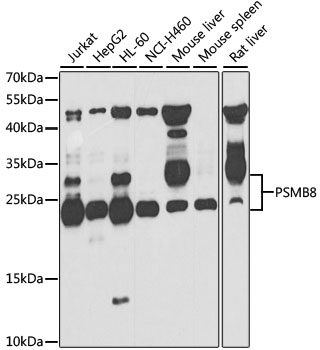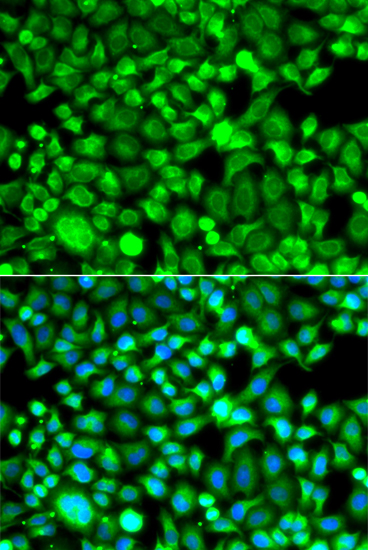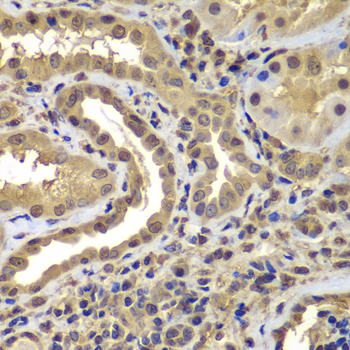Product Detail
Product NamePSMB8 Rabbit Polyclonal Antibody
Host SpeciesRabbit
ClonalityPolyclonal
IsotypeIgG
PurificationAffinity purification
ApplicationsWB,IHC,IF
Species ReactivityHuman,Mouse,Rat
Immunogen DescRecombinant fusion protein of human PSMB8 (NP_004150.1).
ConjugateUnconjugated
Other NamesPSMB8;ALDD;D6S216;D6S216E;JMP;LMP7;NKJO;PSMB5i;RING10
Accession NoSwiss Prot:P28062
GeneID:5696
Uniprot
P28062
Calculated MW29kDa/30kDa
Sdspage MW23-28kDa
FormulationBuffer: PBS with 0.02% sodium azide,50% glycerol,pH7.3.
StorageStore at -20˚C. Avoid freeze / thaw cycles.
Application Details
WB 1:500 - 1:2000
IHC 1:50 - 1:200
IF 1:50 - 1:200
Western blot analysis of extracts of various cell lines, using PSMB8 at 1:1000 dilution.
Immunofluorescence analysis of A549 cells using PSMB8 . Blue: DAPI for nuclear staining.
Immunohistochemistry of paraffin-embedded rat heart using PSMB8 at dilution of 1:100 (40x lens).
Immunohistochemistry of paraffin-embedded human colon using PSMB8 at dilution of 1:100 (40x lens).
Immunohistochemistry of paraffin-embedded human kidney using PSMB8 at dilution of 1:100 (40x lens).
The proteasome is a multicatalytic proteinase complex with a highly ordered ring-shaped 20S core structure. The core structure is composed of 4 rings of 28 non-identical subunits; 2 rings are composed of 7 alpha subunits and 2 rings are composed of 7 beta subunits. Proteasomes are distributed throughout eukaryotic cells at a high concentration and cleave peptides in an ATP/ubiquitin-dependent process in a non-lysosomal pathway. An essential function of a modified proteasome, the immunoproteasome, is the processing of class I MHC peptides. This gene encodes a member of the proteasome B-type family, also known as the T1B family, that is a 20S core beta subunit. This gene is located in the class II region of the MHC (major histocompatibility complex). Expression of this gene is induced by gamma interferon and this gene product replaces catalytic subunit 3 (proteasome beta 5 subunit) in the immunoproteasome. Proteolytic processing is required to generate a mature subunit. Two alternative transcripts encoding two isoforms have been identified; both isoforms are processed to yield the same mature subunit.
If you have published an article using product 55187, please notify us so that we can cite your literature.







 Yes
Yes



